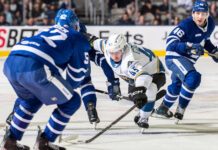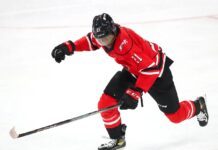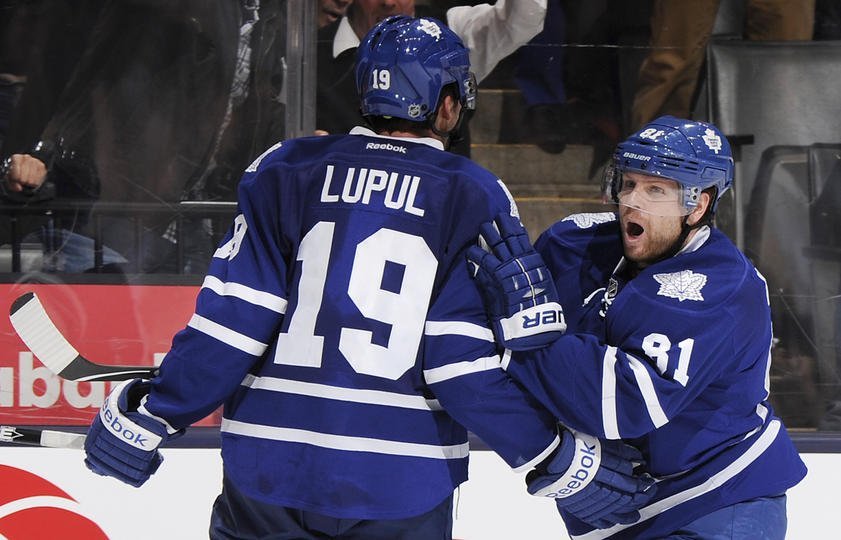One of the more interesting developments in the beginning of Maple Leafs training camp has been the notion of reuniting Joffrey Lupul with Phil Kessel, which would drop James van Riemsdyk down a line.
[quote_box_center]Would that idiot break up that line? You’re saying that [about me]. Or you’re going to say it if I do it.
– Randy Carlyle on changing up the top line[/quote_box_center]
But should we? Let’s take a closer look at how JVR performed with Kessel this season, compared to how Lupul fared in the 2011-12 season.
There are a few things to keep in mind here when comparing the two:
- The Leafs team save percentage was 9th in the league last season at .914%. In the 2011-2012 season, the Leafs had the second worst team save percentage in the league at .898%. When we look at the difference in goals for percentage (GF%), it helps explain why that number is not bigger considering Lupul produced at a better clip than JVR with Kessel.
- JVR played tougher match-ups with not nearly the same zone starts as Lupul received with Kessel, but he did get to play on that line while Bozak had a career year. Overall, by my count, Bozak had 5 primary assists on JVR goals in 2013-2014 (17%) compared to 3 primary assists on Lupul goals in 2011-2012 (12%).
- With noticeably different systems and usage, I wouldn’t put a ton of stock into the Corsi either way, but I included it for those curious. In both instances, each combination outperformed the team average, which is almost a given for anyone who plays with Kessel, but it is worth mentioning because his numbers didn’t tank with Lupul.
- Lupul shot around 1.5% better than his career shooting percentage playing with Kessel in his big year, whereas JVR shot .03% better than his career average last season in a career year of his own.
Here are Phil Kessel’s numbers in each of those seasons with Lupul and JVR:
- There are two significant drops of note. The first is that Kessel’s CF% sunk like a stone without JVR. JVR’s numbers were even worse (32.3%). Why that is, I’m not sure. At times Kessel did go on at the end of games and periods with Jay McClement and Nik Kulemin, which would sewer his numbers without question. He also played almost 100 minutes with Mason Raymond and combined for a 32%CF there.
- The second note is that Kessel’s goals-for percentage shot way down without Lupul. Lupul got hurt to end the season for the final 15 games, they were almost done collapsing, and it was one of the nails in the coffin, so to speak. Understandably, Kessel didn’t have the same hop to his step and his play seemingly suffered due to knowing the team’s fate. Perhaps that’s not why his numbers dropped without Lupul, but from the outside looking in it appeared to be one of the reasons. When Lupul got hurt, Kessel also started seeing steady time with Matt Lombardi, which will sink anyone’s numbers. Kessel and Clarke MacArthur didn’t click very well, either (Kessel had 3 points in 125 minutes with MacArthur).
The point per game Lupul put up with Phil Kessel was an aberration. He’s not a point per game player. However, he’s better than the .64PPG player he was last year (although 22 goals on the second line is still impressive). What we are left with is two simple questions:
- Does it hurt Phil Kessel to play with one of JVR or Lupul over the other?
- Which one of these players can produce at a high level without Kessel while Kessel brings up the numbers of the other?
In the charts above, we can see what most people would logically deduce that Kessel produces regardless of who he is playing with. He’s a real star who produces consistently. In other words, we don’t need to worry about question one.
The second question is two-fold. It seems a lot of people are reading far too much into Joffrey Lupul coming back from injury and lighting the league on fire in an incredible stretch of 13 games. I think there is reason to believe that it was based on timing and a hot streak rather than anything that happened due to the fact he was playing specifically with Nazem Kadri. Lupul shot 26% then. In 2013-14, when Kadri and Lupul were on the ice together, their GF% was 42.3%. Kadri had 16 even strength points playing with Lupul while Joffrey had 15. And they were each other’s most common linemates.
Conversely, we do not have any sort of sample size to go off of for JVR playing without Kessel because that has been his most common linemate since coming to Toronto. But when we look back at his Philadelphia days, he was a positive possession player in all three seasons and had a positive corsi rel in every season. Also of note is that his points per 60 have not gone up drastically since coming to Toronto. His numbers have basically fluctuated between 1.9 and 2.1 over the last four seasons. As I noted way back when the Leafs acquired him, his point totals trended up every year, too. Finally, as previously mentioned in this article, he shot to his career shooting percentage this year. Based on all four of these factors, I think it’s a good bet he would be a safer gamble to contribute more to his norm without Kessel than Lupul, and that Lupul benefits more from playing with Kessel than JVR does.
If that swap was to take place, nobody should expect Lupul to return to being a point per game player, or for JVR to get 30 goals without playing with Kessel, but this kind of change creates a few interesting dynamics here. Without getting too number-y, if Lupul sees a spike in his production somewhere between his previous PPG production with Kessel and his .64PPG with Kadri, and JVR sees a slight drop but stays relatively the same (and PPTOI would play a huge part in this), you’ve just created extra goals and given Kadri a more productive player to play with. The second thing is that JVR has shown flashes of being able to push play forward and cycle well, whereas Lupul never has. Combining JVR with Kadri might allow the Leafs to create a line actually able to control play and push play forward; I stopped short of saying a two-way line, but something close to that could be possible as Kadri matures this year. Simultaneously, it hopefully restores that offensive powerhouse line under the Wilson era, the one that didn’t get beat down possession wise themselves that season. It helps the roster usage, and since the team has depth this year that they didn’t under Wilson, the coaching staff doesn’t have to hammer that high-octane offensive line with heavy minutes.
James Mirtle touched on the Lupul-Kessel connection as well, adding:
[quote_box_center]The last three seasons, in fact, Lupul has played about half his even strength minutes with Kessel, and the Leafs have produced roughly 3.7 goals for every 60 minutes they were together.
When Lupul wasn’t with Kessel, that figure was under 2.5 goals.[/quote_box_center]
The third thing, and maybe it is optimism more than anything, is that it changes the line dynamic if Clarkson were to play with JVR and Kadri versus Lupul in that spot. JVR plies his trade in the same areas of the ice that Clarkson does: in the corners, in front of the net, on the cycle. Compare that to Lupul, who has always been a flashy, one-shot scorer playing more of a skill game (and who appeared ultra-hesitant to drive the net last year; perhaps to avoid injury). You don’t swap Lupul and JVR just to cater to Clarkson, but there is a chance that in doing so it brings out the best in Clarkson, which would obviously be gravy.
Overall, the Leafs have something a lot of teams would kill for: They have a player who is going to get 80+ points as long as he stays healthy. Now they need to figure out how to best utilize that piece in their roster construction and maximize its effect in order bring out the best in others and the team as a whole. Putting Joffrey Lupul with Kessel and giving Kadri a better overall winger in JVR might be one way to do so.



































